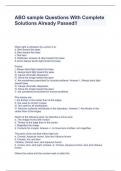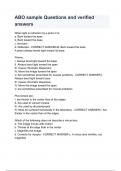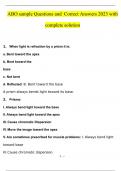Abo sample questions - Study guides, Class notes & Summaries
Looking for the best study guides, study notes and summaries about Abo sample questions? On this page you'll find 325 study documents about Abo sample questions.
All 325 results
Sort by
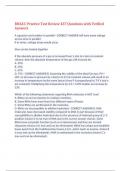 Popular
Popular
-
RNAS C Practice Test Review 437 Questions with Verified Answers,100% CORRECT
- Exam (elaborations) • 128 pages • 2024
-
- $13.49
- 1x sold
- + learn more
RNAS C Practice Test Review 437 Questions with Verified Answers A capacitor and resisitor in parallel - CORRECT ANSWER will have same voltage across since in parallel. if in series, voltage drops would occur they can be treated together If the absolute pressure of a gas is increased from 3 atm to 4 atm at constant volume, then the absolute temperature of the gas will increase by: A. 25%. B. 33%. C. 67%. D. 75% - CORRECT ANSWER B. Assuming the validity of the Ideal-Gas law, PV = n...

-
ABO sample Questions with Complete Solutions
- Exam (elaborations) • 22 pages • 2024
- Available in package deal
-
- $13.49
- + learn more
ABO sample Questions with Complete Solutions When light is refraction by a prism it is: a. Bent toward the apex b, Bent toward the base c. Not bent d. Reflected -Answer-B. Bent toward the base A prism always bends light toward its base. Prisms: I. Always bend light toward the base II. Always bend light toward the apex III. Cause chromatic Dispersion IV. Move the image toward the apex V. Are sometimes prescribed for muscle problems -Answer-I. Always bend light toward base III. Cause...

-
ABO sample Questions and Answers 2024 with complete solution
- Exam (elaborations) • 21 pages • 2024
- Available in package deal
-
- $12.49
- + learn more
ABO sample Questions and Answers 2024 with complete solution When light is refraction by a prism it is: a. Bent toward the apex b, Bent toward the base c. Not bent d. Reflected - Answer ️️ -B. Bent toward the base A prism always bends light toward its base. Prisms: I. Always bend light toward the base II. Always bend light toward the apex III. Cause chromatic Dispersion IV. Move the image toward the apex V. Are sometimes prescribed for muscle problems - Answer ️️ -I. Always ...

-
ABO sample Questions with Complete Solutions
- Exam (elaborations) • 29 pages • 2023
- Available in package deal
-
- $9.99
- + learn more
ABO sample Questions with Complete Solutions When light is refraction by a prism it is: a. Bent toward the apex b, Bent toward the base c. Not bent d. Reflected B. Bent toward the base A prism always bends light toward its base. Prisms: I. Always bend light toward the base II. Always bend light toward the apex III. Cause chromatic Dispersion IV. Move the image toward the apex V. Are sometimes prescribed for muscle problems I. Always bend light toward base III. Cause chromatic dispersion...
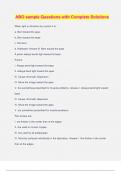
-
ABO sample Questions with Complete Solutions
- Exam (elaborations) • 22 pages • 2024
- Available in package deal
-
- $13.49
- + learn more
ABO sample Questions with Complete Solutions When light is refraction by a prism it is: a. Bent toward the apex b, Bent toward the base c. Not bent d. Reflected -Answer-B. Bent toward the base A prism always bends light toward its base. Prisms: I. Always bend light toward the base II. Always bend light toward the apex III. Cause chromatic Dispersion IV. Move the image toward the apex V. Are sometimes prescribed for muscle problems -Answer-I. Always bend light toward base III. Cause...
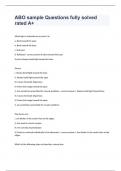
-
ABO sample Questions and answers rated A+ 2023/2024
- Exam (elaborations) • 18 pages • 2024
-
Available in package deal
-
- $14.49
- + learn more
ABO sample Questions and answers rated A+ 2023/2024 When light is refraction by a prism it is: a. Bent toward the apex b, Bent toward the base c. Not bent d. Reflected - correct answer B. Bent toward the base A prism always bends light toward its base. Prisms: I. Always bend light toward the base II. Always bend light toward the apex III. Cause chromatic Dispersion IV. Move the image toward the apex V. Are sometimes prescribed for muscle problems - correct answer I. Always bend li...
ABO sample Questions With Complete Solutions Already Passed!!
ABO sample Questions and verified answers
ABO sample Questions and verified answers
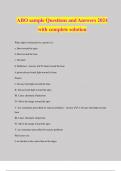
-
ABO sample Questions and Answers 2024 with complete solution
- Exam (elaborations) • 21 pages • 2024
-
- $12.49
- + learn more
ABO sample Questions and Answers 2024 with complete solution When light is refraction by a prism it is: a. Bent toward the apex b, Bent toward the base c. Not bent d. Reflected - Answer ️️ -B. Bent toward the base A prism always bends light toward its base. Prisms: I. Always bend light toward the base II. Always bend light toward the apex III. Cause chromatic Dispersion IV. Move the image toward the apex V. Are sometimes prescribed for muscle problems - Answer ️️ -I. Always ...
ABO sample Questions and Answers 2023 with complete solution

That summary you just bought made someone very happy. Also get paid weekly? Sell your study resources on Stuvia! Discover all about earning on Stuvia



